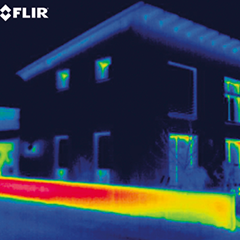We’re delighted to welcome FLIR to the magazine for the first time. The global leader in the design, manufacture and marketing of thermal imaging infrared cameras, the company’s products play pivotal roles in a wide range of industrial, commercial and government applications in more than 60 countries. Today, we turn the spotlight on its activities in the PV arena…
Sales of solar panels are soaring, which helps to reduce CO2 emissions at electricity plants. Over time, solar panels may develop defects which can be easily fixed if detected on time, but they can cause a severe drop in energy production and in some cases even start a fire if left unchecked. That is why more and more solar panel installers cooperate with experienced thermographers that offer regular thermal imaging inspections to ensure the safety and effective deployment of solar systems.
Background
As their temperatures rise, solar panels become less efficient, producing less electricity. Some defects can cause them to break down or even produce a reverse current, which might damage the entire solar plant. Thermal imaging cameras can be used to detect hot spots in the panels from a distance, which makes it a lot easier to find defects before they become devastating breakdowns.
The Italian solar panel installation company ELEM srl is one of the companies that is working together with Thermographic S.A.S. di Ermoni Alberto e C., an experienced thermographic inspection agency to offer thermal imaging inspections to their clients. This Melzo, Italy, -based thermography agency offers thermographers with several decades of experience with thermography. One of these inspectors is Alberto Ermoni, a Level II certified thermographer.
“Thermal imaging cameras from FLIR Systems are the ideal tool for the inspection of solar panels”, says Ermoni. “This inspection method is non-destructive and non-invasive. You can use thermal imaging to inspect the solar panels under load, so no shutdown is required. When used properly, thermal imaging cameras will show accurate temperature differences between cells or within a single cell that allow you to identify faults in an early stage.”
Inspect the entire system
These inspections are also not limited to the solar panels alone. “You can use thermal imaging to inspect the entire system, from the solar panels themselves to connections, inverters, fuses and all other electrical components in the system”, explains Ermoni. “If any part of the systems starts to wear down or develops a higher resistance for some other reason, the corresponding increase in temperature can be detected very easily with a thermal imaging camera, so you can fix the problem before the system fails.”
The thermal imaging camera Ermoni uses for these inspections is the FLIR T640bx. “This camera combines top notch image quality with advanced features like wireless WiFi connectivity with a tablet PC and a wireless Bluetooth connection to selected Extech test and measurement tools with the MeterLink feature, such as the Extech EX845 clamp meter. These wireless connections really make a huge difference. Another feature that I use often is the Picture-in-Picture feature. This overlay of a thermal image over the visual image allows me to better localize the hot spots.”




















